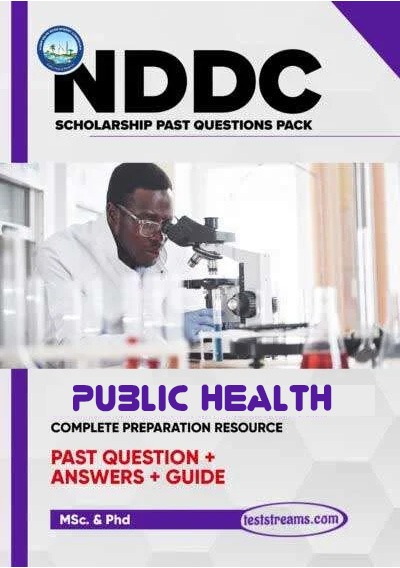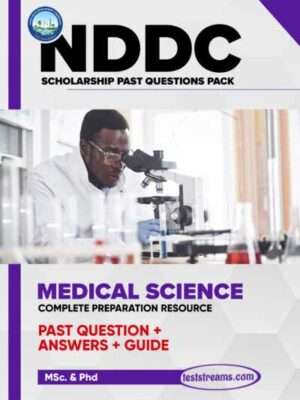Description
NDDC Public Health Scholarship Aptitude Test
Looking to pass the NDDC Postgraduate Scholarship in Public Health. This past questions pack is compiled to assist in preparing effectively and pass with confidence. Carefully compiled from real exam formats and updated, this digital product provides a comprehensive collection of aptitude test questions and detailed answers specific to the Public Health discipline just like what you’ll see on exam day.
About the NDDC Public Health Scholarship
The Niger Delta Development Commission (NDDC) offers fully-funded foreign postgraduate scholarships to qualified candidates from the Niger Delta. The selection process includes a competitive Computer-Based Test (CBT) this pack helps you ace that test.
What’s Inside This Pack:
Real Time Practice Questions
Fully Solved Answers and Step-by-Step Explanations
Covers All 4 Major Sections: Numerical Reasoning, Verbal Reasoning, Abstract Reasoning Public Health Knowledge
Instant PDF Access
Key Benefits
The benefits of the NDDC Public Health Scholarship Aptitude Test
Up-to-date for 2025 NDDC Scholarship Test
Designed specifically for Public Health applicants
Easy to use on mobile, tablet, or desktop
Save hours of prep time with focused study material
Boost your confidence with real time exam practice questions
Who This Product Is For
Graduates applying for the 2025 NDDC Public Health Scholarship
Students from Niger Delta states (Rivers, Delta, Bayelsa, Akwa Ibom, etc.)
Public health professionals seeking foreign postgraduate opportunities
Anyone who wants to maximize their test score
SAMPLE QUESTIONS
Question 1:
A survey showed that 60% of a community of 1,200 people are vaccinated. How many people are unvaccinated?
A. 480
B. 500
C. 520
D. 600
E. 720
Answer: A. 480
Question 2:
A health worker distributes hand sanitizers at the rate of 75 bottles per hour. How many will she distribute in 6.5 hours?
A. 487
B. 490
C. 495
D. 500
E. 510
Answer: C. 487.5 (rounded to 488)
Question 3:
Read the passage and answer:
“Malaria remains one of the most deadly diseases in sub-Saharan Africa, particularly affecting children under 5 years of age. While preventive methods like insecticide-treated nets (ITNs) are effective, access remains a major barrier.”
Which of the following is true according to the passage?
A. ITNs do not prevent malaria
B. Only adults are affected by malaria
C. Children under 5 are among the most vulnerable
D. There is no prevention for malaria
E. Malaria only occurs in Africa
Answer: C. Children under 5 are among the most vulnerable
Question 4:
Choose the correct synonym of the word “mitigate”:
A. Prevent
B. Reduce
C. Complicate
D. Delay
E. Ignore
Answer: B. Reduce
Question 5:
Which shape comes next in the sequence?
🟦 ➡ 🟥 ➡ 🟨 ➡ 🟪 ➡ ?
A. 🟩
B. 🟫
C. 🟧
D. 🟨
E. 🟥
Answer: A. 🟩 (Cycle through colors)
Question 6:
Find the odd one out:
A. ◼️
B. ⬛
C. ◻️
D. 🟥
E. 🟩
Answer: C. ◻️ (The only white shape)
Question 7:
Which of the following is a non-communicable disease?
A. Malaria
B. HIV
C. Tuberculosis
D. Hypertension
E. Cholera
Answer: D. Hypertension
Question 8:
Which agency is primarily responsible for disease surveillance in Nigeria?
A. WHO
B. FMOH
C. NCDC
D. NAFDAC
E. UNICEF
Answer: C. NCDC
Question 9:
Which of the following best describes herd immunity?
A. Immunizing all children
B. A population becoming resistant due to widespread immunity
C. Reducing access to the disease vector
D. One person infecting the entire population
E. Travel restrictions for disease control
Answer: B. A population becoming resistant due to widespread immunity
Question 10:
What is the basic reproductive number (R0) used to describe?
A. The cost of vaccination
B. Mortality rate
C. Number of hospital beds
D. How contagious a disease is
E. The recovery time
Answer: D. How contagious a disease is











Reviews
There are no reviews yet.